
Monster Hunter Rise Review
Monster Hunter succeeded at reinventing itself with 2018’s Monster Hunter: World, reinvigorating a longstanding franchise in ways that even veteran fans like myself didn’t even know we wanted. Instead of constraining hunters to small, individualized zones with load times when moving across each section of any given map, World took the approach of making each map interconnected and seamless – opening the door to much more granular interactivity between monsters, the hunters, and the environments themselves.
Such a radical change to the series’ main mechanics meant that Monster Hunter: Rise – the Nintendo Switch follow-up to World – was always destined for scrutiny. Would it feel more like the “old” style, or the “new”? It’s clear that some sacrifice was always going to be made to get a similar experience on the Switch, but just how well does the game manage to rise above its target hardware’s shortcomings?
Booting up Rise, one thing’s clear – even if the game has seen a technical downgrade from Monster Hunter: World, the game still looks and runs absurdly well for the Switch. While the game might not run at a native resolution in either docked or handheld mode, it’s never a low enough resolution to be distracting – and the same goes for the framerate. While it’s capped at 30FPS, the majority of the time the game reaches that target with ease, even once things get crazy during the later, and visually intense, Rampages.
Rise keeps the sandbox design from Monster Hunter: World’s maps, though some of the interactivity present within them has seen some culling to deal with the reduced power of the hardware. Endemic life, while they can still be found dotted across the map, are much less prevalent; with the only ones present being those that have a direct impact on gameplay. While portions of the environment can still be destroyed by stray monster attacks, nothing like the waterfall from the top of the Ancient Forest or the pit from the Wildspire Wastes exists in Rise’s locales; in other words, nothing that would lead to a dramatic change in a levels topography.
Capcom makes up for this technical limitation, by including a greater focus on freedom of movement and verticality with the new Wirebug system. Players by default have access to two charges of the critters, which will replenish at different rates depending on what they’re used for – dotted across the map, you’ll also be able to find an additional Wirebug to add to your repertoire temporarily. You can use Wirebugs to slingshot your hunter through the air, and shooting yourself into most walls will lead to your hunter running up the incline for as long as their stamina will allow. In the middle of a Wirebug dash you can even initiate an air roll to both correct for errors in your initial aim, as well as to travel further distances at the expense of your ability to wallrun. Naturally, you can chain multiple Wirebug dashes together by expending additional charges.
Hunter Arts, which were previously featured in Monster Hunter Generations and Generations Ultimate also make a return with the Wirebug system – this time classified as Silkbind Attacks. In practice, they work identically to how they did in Generations, though instead of requiring players to raise up a bar before activating, they use the same Wirebug charges that players naturally replenish over time after each use. These, along with any aerial attacks, contribute to eventually opening up a monster into a mount, allowing you to control a monster to either bash them repeatedly into a wall, or even to reek havoc on any other poor unsuspecting monster within the vicinity.
It’s no exaggeration to say that the extra utility afforded by Wirebugs are at the core of Monster Hunter Rise’s design; from the map layouts, to the enhanced weapon movesets, and even down to the attacks for both new and returning monsters. I definitely noticed that monsters are faster to account for the players enhanced mobility, and it certainly feels like they hit harder than they normally would for a basegame Monster Hunter, too. This is balanced out with what feels like slightly reduced monster health across the board; this is easily most noticeable during Village Quests, but can clearly be seen during multiplayer Hub Quests as well.
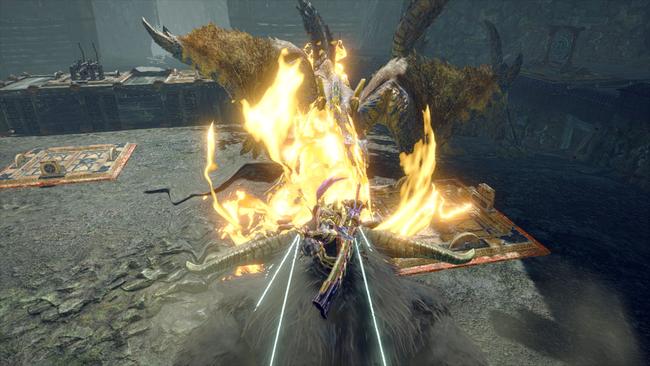
If you started your Monster Hunter journey with Monster Hunter: World, you may be confused about now – Monster Hunter: Rise, much like other entries in the series prior to World’s release, separates singleplayer and multiplayer hunts into Village and Hub Quests respectively; previously this meant that players would’ve had to juggle singleplayer and multiplayer progression separately, but thankfully the system has been tweaked to reduce redundancy with Rise. The singleplayer Village quests only proceed through Low Rank hunts, and players can unlock their Hunter Rank for the Multiplayer Hub through completing “Special License Tests” that are unlocked upon reaching special milestones in the Village. Hub progress cannot be transferred over to the Village quests in quite the same way.
Speaking of multiplayer, we had the chance to test out online connectivity with other members of the press for a limited time-frame before launch. Players should be more than pleased to know that Capcom have done a splendid job at making sure the game’s netcode is stable, consistent, and a good experience for everyone involved. We played literally dozens of hours of multiplayer with players across the world with little to no issues; while we did experience an error one or two times, the vast majority of our multiplayer playtime was essentially flawless.
While there were concerns among the playerbase that Rise might not include many of the Quality-of-Life features that World brought to the table, I can safely put those fears to rest – for better or worse. Monster Hunter Rise’s weapon upgrade tree works and looks identical to Monster Hunter: World’s. One exception is that some weapon upgrades utilize a system from Monster Hunter: Generations, where you could occasionally use any of a monster’s materials as part of the recipe for an upgrade. The Skill Point system, similarly, works identically to how it was handled in Monster Hunter: World, with one key exception – set bonuses.
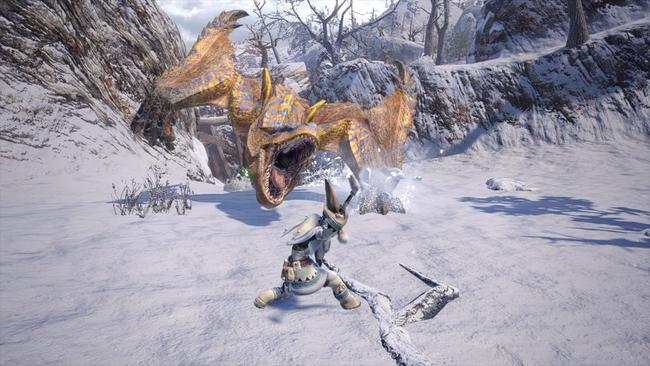
In Monster Hunter: World, players were incentivized to match pieces of armor from the same set in order to activate unique bonus skills that you might not gain access to otherwise, or to unlock further levels of specific skills that would remain gated off unless you deliberately chose to base your builds around a specific armor set. This was an interesting and rewarding reason for players to branch out and try different armors as they progressed through the game, as it opened the door to unique playstyles organically, and gave you a reason to try out different armor sets, even if you might’ve already been happy with the one you were currently using. Rise’s implementation, however, does the opposite.
Instead of rewarding you for branching out and trying different armor sets by dangling unique skills attached to them, there’s now a base bonus to elemental resistance for stacking as many pieces of the same armor set onto your build as possible. I’ll be blunt; I don’t like this change. Instead of rewarding you for broadening your horizons, it feels like the game admonishing you for attempting to take full advantage of the armor pieces that you have available to you. It’s not a major complaint, admittedly – but I just can’t see the point in the change, when everything else about the armor system is either a carbon copy of World’s implementation, or fixing a questionable change that World’s system brought to the table.
On the flip side, Monster Hunter: Rise returns the charm and decorations system to its rightful place. Monster Hunter: World players will recognize that decorations were slotable jewels that you could attach to armor pieces and weapons to augment your activated skills, granting you access to further skills that were otherwise absent from your armor – and that charms were upgradeable equipment dedicated to a specific skill. In World, decorations were random drops from specific hunts, or could be targeted with melding, while charms were bog-standard equipment that could be crafted – in previous games in the series, those two positions were flipped. Decorations could be crafted with monster parts, and Charms were randomly dropped or melded.
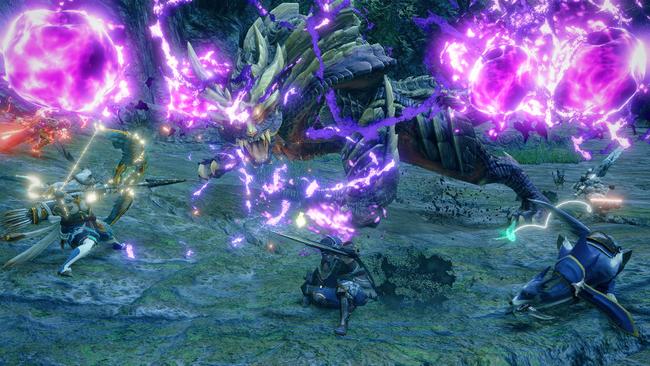
While I accepted the change with World, it’s clear that the system was a timesink for the sake of a timesink. Whereas a single Charm could maybe be the difference between you having access to an additional skill or two in previous games; World’s Decorations meant that your entire endgame builds could be held at the mercy of RNG.
Since you always had to craft Decorations with specific monster parts in previous games anyways, you were still beholden to grinding – but suffering through and hoping for a handful of equipment certainly beats out grinding drops for dozens of them. The manner in which hunters generate charms relies on them donating monster parts to a melding pot, and setting a skill they wish to target. While you’re never guaranteed to receive the skill you want – you generally have a fairly good shot at it, so as you’re grinding away at other pieces of equipment, an ideal charm is never that far away.
Choosing the appropriate food you want for their buffs has also been streamlined, and is now the most straightforward implementation of the mechanic that the series has seen. Players choose three Dango to eat at a time, and each Dango Ball comes with a chance to activate a specific buff, in addition to the base Health and Stamina upgrades that come standard with every meal. There’s no worrying about the combined effects of different ingredients, or deliberating about any interactivity between your choices at all; you simply choose which buffs you want to try and activate; and maybe use a Dango Ticket, if you have one, to guarantee their effects.
Besides the Wirebug, the most significant mechanic that Rise has added to the formula are Rampage Quests. These quests task players with building up their defenses and fending off a horde of monsters attempting to infiltrate Kamura Village. It’s a weird mode for the series, not even comparable to siege quests of the past – instead, it’s a Tower Defense. Place Ballista, Cannons, and several other weapons and obstacles to push back against the flow of invaders, using the Wirebug to hop from one station to the next, depending on what the situation calls for. The mode as a whole isn’t the most entertaining to tackle when you’re running solo, but with a group of hunters it’s a total blast to play – for the first couple of runs, at least.
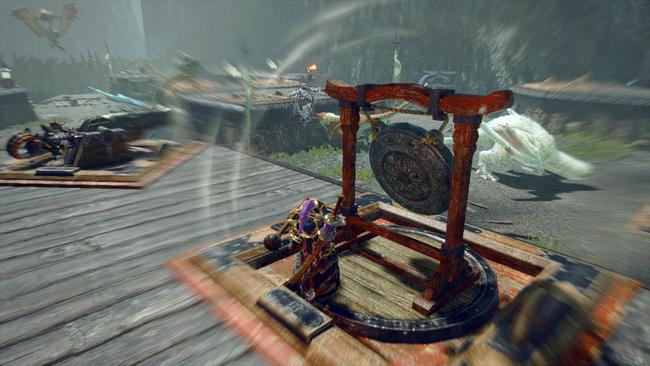
When it comes down to it, Rampages feel like a missed opportunity. It works, but there simply wasn’t enough variety for my interest to last. Although you have dozens of types of monsters attacking the village, all of them blend together into their specific class. Tank-y monsters will rush the gates and require your attention to deal with as soon as possible, flying monsters will ignore obstacles and attempt to distract you from other attackers, and the horde of “standard” units act as little more than a damage sponge. Worst of all, once the Counter Gong rings – which it will – it ends up not really mattering what your defenses looked like. At that point, it’s best to tackle the hoard with your regular weapons, which receive an incredibly large buff to their attack power during the effects of the Counter Signal.
What makes Rampages all the more disappointing, is the fact that – at least at launch – they’re what constitutes Rise’s endgame. Rampage materials are required, in some cases, to “Ramp-up” your gear to attain specific boosts – and there’s even a specific set of Rampage Gear that is almost always objectively better once you spend the time to grind it up to its full strength. Instead of any specific monsters that players will be tasked with dealing with at the endgame, they’re instead subjected to a game mode that might start out entertaining enough, but within time quickly starts to feel the same with every run. Having more than one map for the encounters certainly would’ve helped, but I don’t think that change alone will be enough to keep the Rampage engaging. Apex monsters certainly don’t offer enough of that, either.
If there’s any silver lining to matters, it seems clear that a portion of Rise’s endgame was excised from the basegame for Title Updates 1 and 2, coming later this year. The Blacksmith still shows that there are more weapons to be discovered, the final boss ends off on a cliffhanger, and some baffling omissions from the monster roster give the distinct impression that perhaps the game wasn’t fully ready for launch. The fact that players will have to wait until Title Update 1 in Late April to accomplish something as simple as unlocking their Hunter Rank makes it incredibly hard to see the situation as anything other than the game itself is launching in an unfinished state.
That being said, the content that is here – Rampage’s aside – is impressive. New and returning monsters make impressive use of the mechanics, and the newcomers especially showcase creativity to their designs that just wasn’t present with Monster Hunter: World. Almudron and the new flagship monster Magnamalo were my standout favorites, but really every monster new to the series with Rise are an absolute joy to fight.
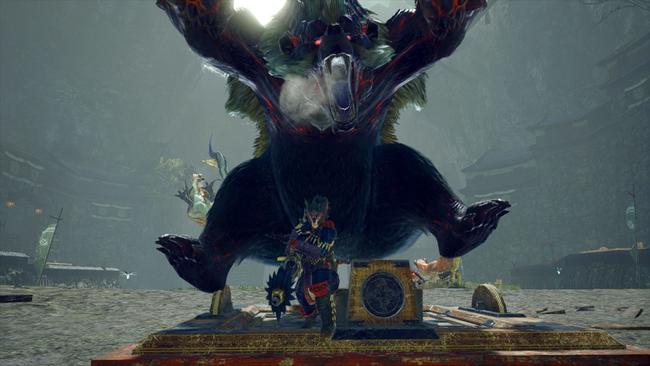
There are other aspects of Monster Hunter: Rise’s design that deserve props. Palamutes are an excellent addition to the series formula, and it would be a shame if they end up restricted to Rise, just as hunting as Palicos themselves has remained limited to Monster Hunter Generations and its expansion. Similarly, the training area – although it's never been a tool I’ve found much use for, personally – has never been better. All of the little details littered across Kamura village, such as the unique vocal tracks for each individual area of the hub, never failed to put a smile on my face.
When I killed Monster Hunter: Rise’s final boss, there was nothing more that I wanted to do than to play more of the game. With the state of the game as it stands, however, it’s hard to feel like there’s any real reason for me to do so. It seems inevitable that this complaint will subside in time, with what is sure to be a steady stream of updates over the years; but I’m not reviewing Monster Hunter: Rise a year out from now. I’m reviewing it in the state that the game finds itself in at launch.
There’s a framework of a great game here, and the changes and additions to the formula belay what feels like an even more significant step forward for the series than Monster Hunter: World. But that promise hasn’t yet come to fruition. I’m sure that one day Monster Hunter: Rise will be my favorite game in the series, but the road to reach that destination has only started. As for now, we’re left with an entry that ticks almost all of the boxes, but with some glaring exceptions. Monster Hunter: Rise is a great game; but it can, and should, be a fantastic one.